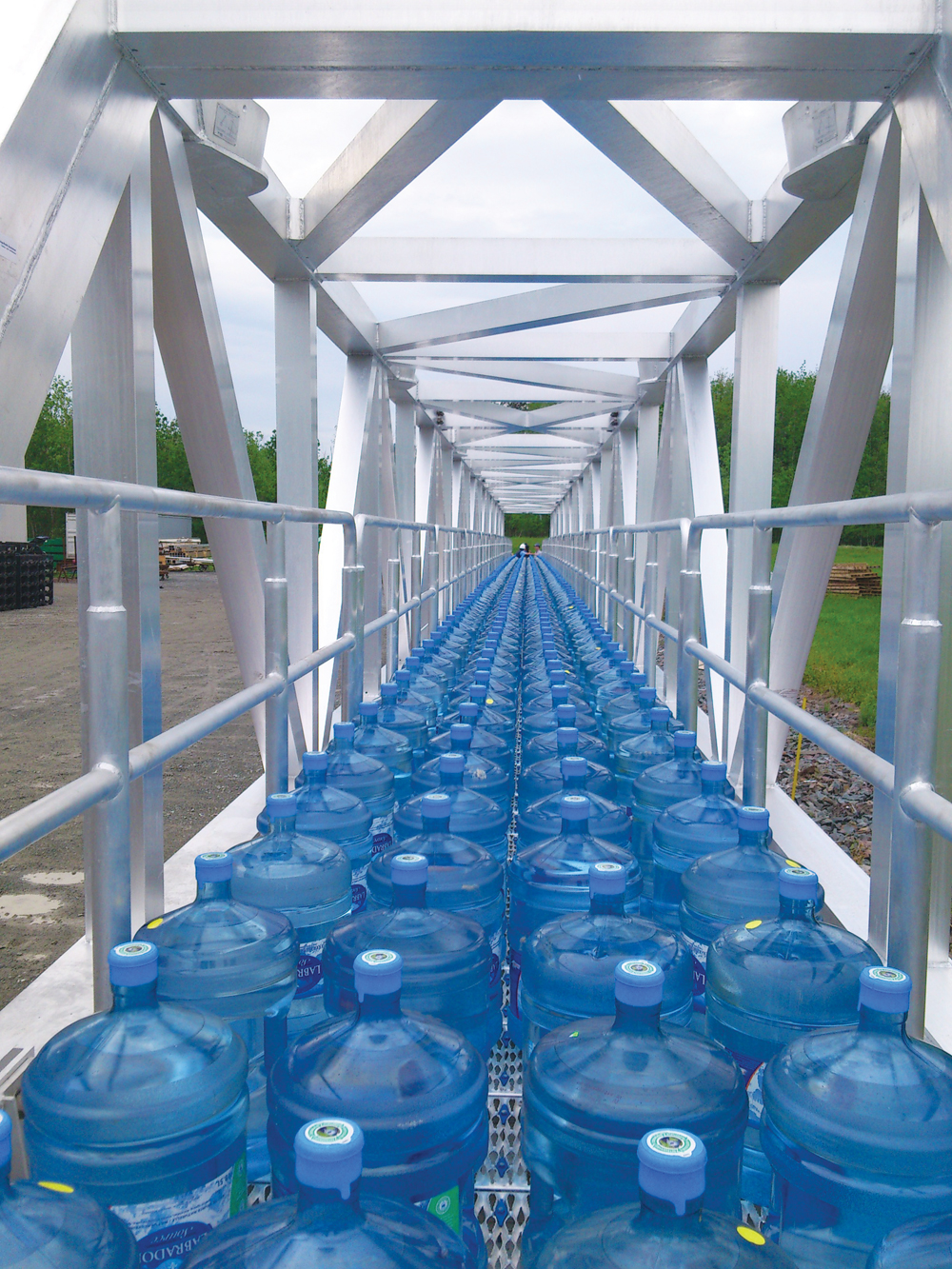Montreal-based MAADI Group recently designed a 151-foot-long, 6½-foot-wide pedestrian work bridge to connect platforms in the West Philippine Sea. Using high-strength aluminum for the bridge’s material, MAADI designed the bridge with lateral movement capability that could withstand deep-ocean movement and wind gusts up to 200 km/hr (124 mph).
MAADI’s President/CEO, Alexandre de la Chevrotière, says that water and wind movements can cause the platforms to shift by as much as one inch, so the bridge was engineered to account for movement up to one meter. A trolley system at one end of the bridge allows slight back-and-forth movements of the bridge between the platforms.
The span was built in four sections. Its abutments are unique, according to de la Chevrotière, in that their pin connections rotate on two axes. There’s also a pin connection at the top of the trolley, which allows the bridge to move in several different directions by as much as three degrees to account for ocean movements, he says.
The 13-ton bridge was built to accommodate up to 80 workers on deck. (The accompanying image shows 8.4 tons of water being used to test the span’s load capacity.) The bridge’s camber was designed to reduce the deflection caused by dead and live loads.
“Aluminum is the material of the future,” says de la Chevrotière. “It doesn’t rust and it’s maintenance free.”
Read about more innovations from BD+C's 2014 Great Solutions Report.
Related Stories
| Aug 24, 2011
Deadline Extended: 2012 "Best AEC Firms to Work For” Awards
We’re looking for firms that create truly positive workplaces for their AEC professionals and support staff. In other words, this awards program will recognize those AEC firms that nurture and develop their most valuable asset—their people.
| Aug 23, 2011
Acoustical design education model
Pass this exam and earn 1.0 AIA/CES Discovery learning units. You must go to www.BDCnetwork.com/EnhancedAcousticalDesign to take this exam.
| Aug 19, 2011
Thought Leader: Boyd R. Zoccola, chair and chief elected officer of BOMA International
Boyd R. Zoccola is Chair and Chief Elected Officer of BOMA International. A BOMA member since 1994, he has served on the Executive, Finance, Investment, and Medical/Healthcare Facilities Committees. An Indiana Real Estate Principal Broker and a board member of the Real Estate Round Table, he is Executive Vice President of Hokanson Companies, Inc., of Indianapolis, and has been involved in the development of $600 million worth of real estate. On a volunteer basis, Zoccola was president of Horizon House and a board member of Girls, Inc. He holds a BA in biology from Indiana University.
| Aug 19, 2011
How and why AEC professionals choose flooring systems
Design and construction professionals who completed our flooring survey had strong opinions about their preferred flooring type.
| Aug 19, 2011
Underfloor air distribution, how to get the details right
Our experts provide solid advice on the correct way to design and construct underfloor air distribution systems, to yield significant energy savings.
| Aug 19, 2011
Enhanced acoustical design
Ambient noise levels in some facility types are trending up and becoming a barrier to clear communication between building occupants.
| Jul 22, 2011
The Right Platform for IPD
Workstations for successful integrated project delivery, a white paper by Dell and BD+C.
| Jul 22, 2011
High-performance windows and doors
Learning objectives After reading this article, you should be able to: Understand issues of thermal performance and energy efficiency in relation to window and door systems; describe optimal detailing of the window-wall interface and how it contributes to building performance, sustainability, and occupant well-being; understand how durability contributes to sustainable windows/doors; and list sustainable O&M requirements for window and door systems.
| Jul 21, 2011
Falling Architecture Billings Index reflects decrease in design demands
This months Architecture Billings Index (ABI), provided by the American Institute of Architects, is almost a full point lower than last month’s reported score. June’s reading of 47.2 was short of the required 50 to achieve billings increases, making July’s reading of 46.3 an unwelcome sign of market tidings.















